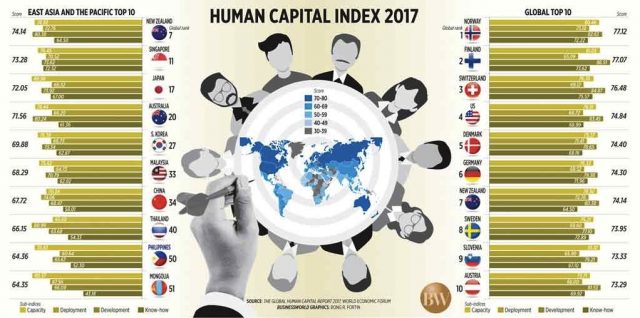MANILA – The Philippines has remained among East Asia and the Pacific’s top 10 economies in terms of human resource development, according to an annual report of the World Economic Forum that nevertheless showed the country slipping in regional and global ranking, weighed down by challenges in skills application and accumulation through work.
The World Economic Forum’s Human Capital Report 2017 showed the Philippines slipping to ninth place in East Asia and the Pacific from eighth spot last year, with a global rank of 50th out of 130 countries and a score of 64.36 on a scale where 100 is the “best” mark, down from 49th spot — also out of 130 economies — with a 71.75 grade in the 2016 roster.
The Philippines’ score fell below East Asia and the Pacific’s 65.77 average this year, but bested the region’s 69.75 grade last year.
China, which ranked 11th in East Asia and the Pacific and 71st globally last year with a score of 67.81, broke into the region’s top 10 this year, dislodging Vietnam (now 64th globally with a score of 62.19) from the group and jumping over Mongolia (10th in the region and 51st globally with a 64.35 grade), the Philippines and Thailand (eighth in the region and 40th globally with 66.15) to land seventh spot in the region and 34th globally with a 67.72 grade.
The index ranks 130 countries on how well they are developing their human capital on a scale from 0 (worst) to 100 (best) across four dimensions, namely: capacity, deployment, development and know-how, and five age groups: 0–14 years; 15–24 years; 25–54 years; 55–64 years; and at least 65 years old.
“It can be used as a tool to assess progress within countries and points to opportunities for cross-country learning and exchange,” the report explained.
The “capacity” subindex measures gains in education; “deployment” covers skills application and accumulation of skills through work; “development” quantifies efforts to educate, train and upgrade the skills of students and the working-age population; while the “know-how” subindex “captures the breadth and depth of specialized skills used at work”.
Measured against these subindices, the Philippines placed:
• 19th with a score of 78.8 in terms of capacity, which covers literacy and numeracy, as well as primary, secondary and tertiary education attainment;
• 60th with 65.7 in terms of development, covering primary, secondary, tertiary and vocational education enrolment; quality of primary schools; quality of education system; skill diversity of graduates and extent of staff training;
• 60th with 52.3 in know-how, covering share of medium and highly skilled workers, availability of skilled employees and economic complexity (which measures degree of sophistication of a country’s “productive knowledge” as shown in the quality of its exports);
• 87th with a grade of 60.6 in terms of deployment, covering labor force participation rate, employment gender gap, as well as unemployment and underemployment rate.
Sought for comment, Labor Undersecretary Joel B. Maglungsod, whom the administration of President Rodrigo R. Duterte had plucked from the leftwing labor movement to serve in government, said that while the current government’s P8.44-trillion “Build, Build, Build” infrastructure development program may help improve human resource use in the Philippines, it is “temporary” and not “strategic in nature” when it comes to developing human capital “[k]asi pagkatapos ng (because after) infrastructure and construction (is completed), wala na(development and use of human resource ends).”
“We really need to develop agriculture and our manufacturing sector, as well as processing of raw materials in mining for instance,” Mr. Maglungsod said partly in Filipino and English, referring to the administration’s intention to end the export of metal ore and develop local processing capability.
“In order to establish economic stability, you also have to stabilize workers in their employment, because workers are the primary force of our economy,” he added in a telephone interview, citing the need to tighten restrictions on contractual hiring of workers.
The World Economic Forum noted in its report that “[a]t a global level, only two (regions) — North America and Western Europe — have developed more than 70% of their human capital versus the ideal score.”
“Three regions — Eastern Europe and Central Asia, East Asia and the Pacific and Latin America and the Caribbean — score in the 60-70% range, while the Middle East and North Africa, South Asia and Sub-Saharan Africa have yet to cross the 60% threshold.”
In East Asia and the Pacific, “[t]he gap between the best and worst performers is among the largest of any region, reflecting in part the different stages of economic development of the 16 countries covered in the index, as well as the varying degrees of human capital development that exist between countries with similar income.”




